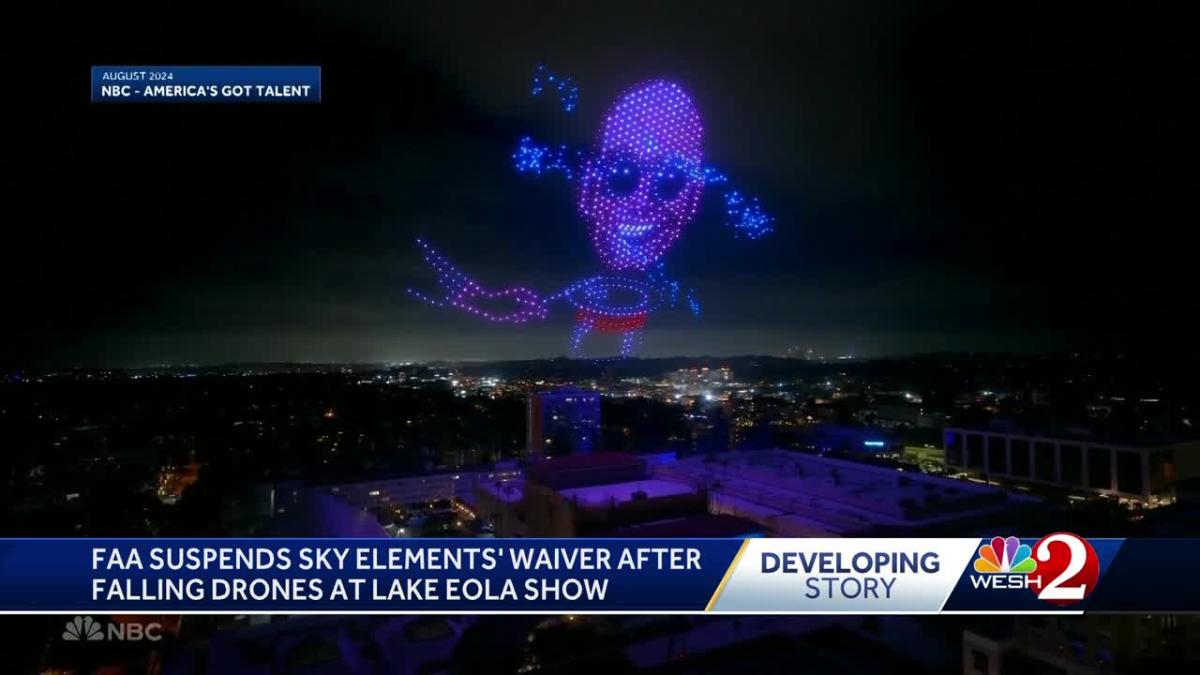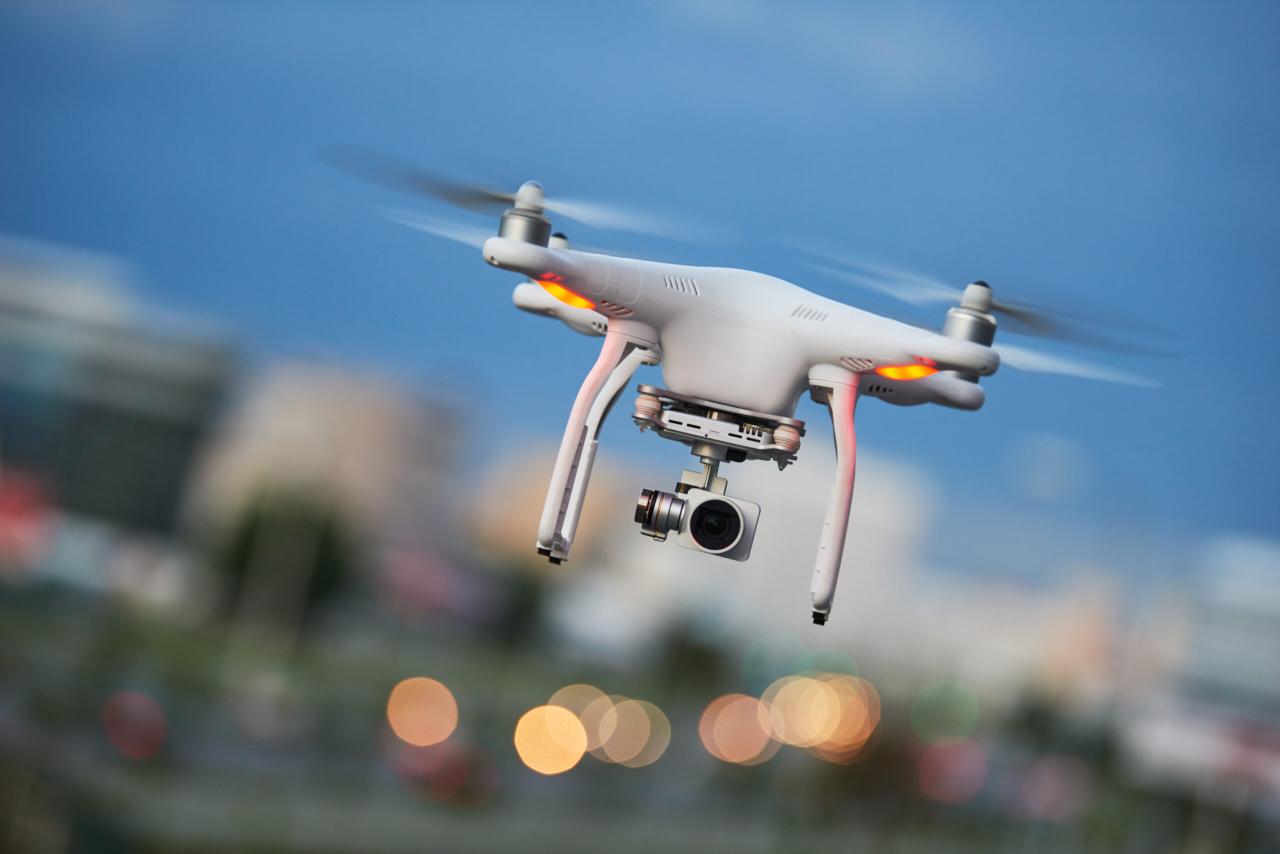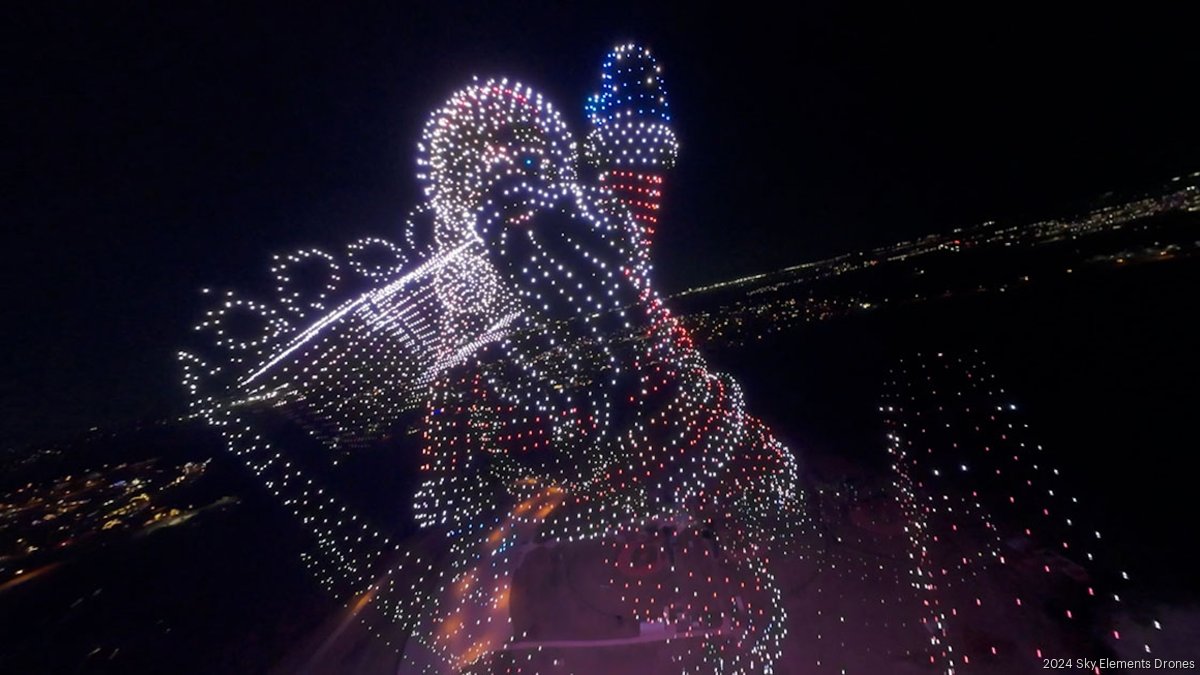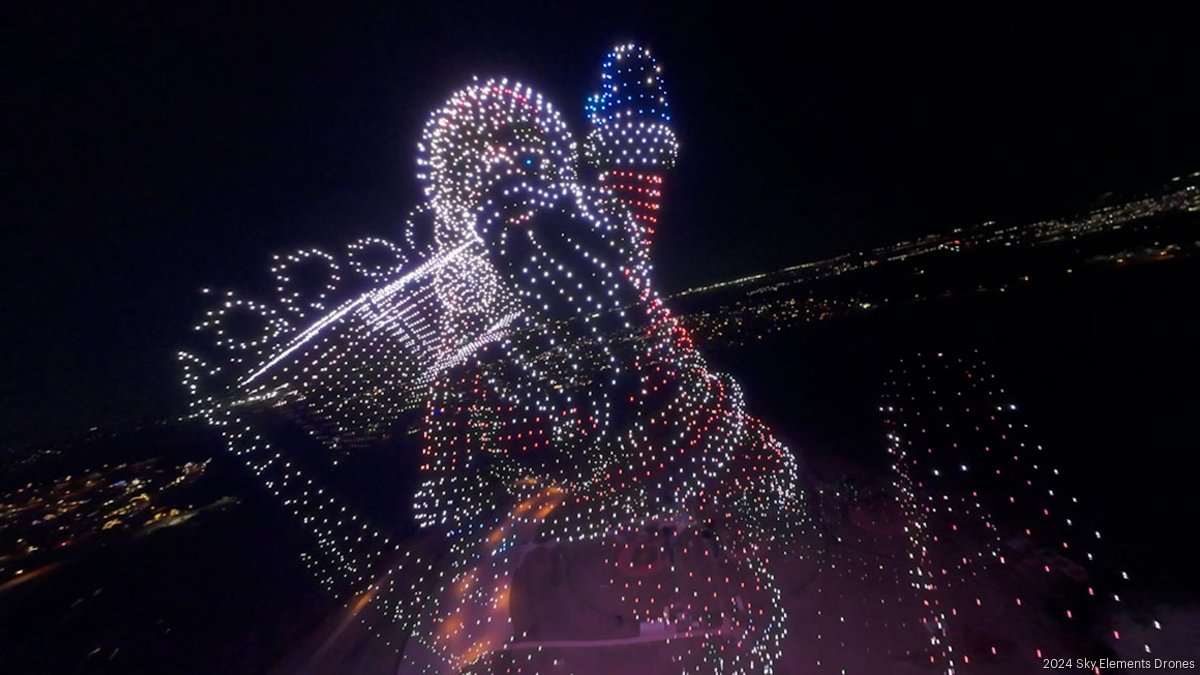Orlando drone show accident: This captivating story unfolds, revealing the intricacies of a spectacular mishap involving a swarm of drones during a nighttime aerial display. We’ll explore the technical glitches, human errors, and regulatory aspects that contributed to this unexpected event, examining the aftermath and lessons learned. Prepare for a detailed look at this incident, from the initial malfunction to the subsequent investigation and safety recommendations.
The accident involved a large-scale drone show featuring numerous advanced quadcopters. A chain of events, potentially including software malfunctions, operator error, or unforeseen weather conditions, led to the drones behaving erratically, resulting in a mid-air collision and subsequent ground impact. This analysis will delve into each contributing factor to understand how such a seemingly controlled event could go so drastically wrong.
Accident Overview

The Orlando drone show accident, while thankfully resulting in no serious injuries, highlighted the potential risks associated with large-scale drone displays. The incident involved a malfunction during a nighttime aerial performance, causing several drones to deviate from their programmed flight paths. This resulted in a chaotic scene, albeit one that was quickly brought under control by emergency personnel.The drones involved were reportedly commercially available models, likely quadcopters, commonly used in professional drone shows.
While precise specifications regarding their make, model, and individual payloads weren’t publicly released immediately following the event, it’s reasonable to assume they were equipped with high-intensity LED lights for the visual spectacle, GPS modules for autonomous navigation, and possibly obstacle avoidance systems. The exact capabilities of these systems and whether or not they contributed to or mitigated the accident remains under investigation.
Timeline of Events
The drone show commenced at the scheduled time, with hundreds of drones taking to the sky in a synchronized formation. The initial portion of the show proceeded without incident, showcasing intricate patterns and dynamic light displays. Approximately halfway through the performance, several drones exhibited erratic behavior, veering off course and colliding with each other. The show was immediately halted, and emergency response teams were deployed to secure the area.
Following a period of assessment, the remaining drones were safely landed, and the area was declared safe.
Injuries and Property Damage
While initial reports suggested potential damage to property, such as minor damage to nearby vehicles, these reports were largely unsubstantiated in the following days. Fortunately, no serious injuries were reported among the spectators or personnel involved in the show’s operation. The primary damage was confined to the affected drones themselves, which sustained varying degrees of damage from the collisions.
The overall financial impact, including repair costs for the drones and any potential property damage, is still being evaluated.
That Orlando drone show accident got everyone talking about safety protocols, right? It made me think about similar incidents, like that recent drone crash in Paris , which highlighted the importance of redundant systems. Learning from both incidents is crucial to preventing future Orlando-style mishaps and ensuring safer drone operations everywhere.
Regulatory Compliance

The Orlando drone show accident raises critical questions about the adherence to Federal Aviation Administration (FAA) regulations governing drone operations. A thorough investigation is needed to determine the extent of compliance, or lack thereof, by the operator(s) involved. This section will analyze the regulatory framework applicable to drone shows of this scale and evaluate the operator’s actions against those standards.The FAA has a comprehensive set of rules and regulations for unmanned aircraft systems (UAS), commonly known as drones.
That Orlando drone show accident really got people talking about safety regulations, huh? It makes you wonder about the logistics of widespread drone use, especially considering places like the ones listed on this site showing amazon drone delivery locations. Thinking about all those potential delivery points highlights just how crucial reliable drone technology and strict safety protocols are to avoid similar incidents in the future.
These regulations cover various aspects, from registration and certification of the drone and operator to operational limitations and airspace restrictions. Compliance with these regulations is paramount for ensuring public safety and preventing accidents. Failure to adhere to these regulations can lead to severe penalties, including hefty fines and even criminal charges.
FAA Regulations and Permits, Orlando drone show accident
The operator of the Orlando drone show was obligated to comply with several key FAA regulations. These include, but are not limited to, proper registration of the drones used, holding a Remote Pilot Certificate with a suitable rating, filing a flight plan, and obtaining any necessary airspace authorizations. Specific regulations relevant to drone shows, such as those concerning nighttime operations, crowd safety, and emergency procedures, also apply.
The investigation will need to determine if all necessary permits and licenses were obtained prior to the show, and if all operational parameters specified in those permits were followed. Failure to obtain the necessary authorizations or to operate within the limitations specified in those authorizations would constitute a clear violation of FAA regulations.
Safety Protocols Implemented During the Show
Effective safety protocols are essential for any drone show, especially those involving a large number of drones and spectators. These protocols should address potential hazards such as malfunctioning drones, loss of control, and collisions. Pre-flight checks, contingency plans for various scenarios (including power failures or loss of signal), and well-defined emergency procedures are crucial. The investigation will determine what safety protocols, if any, were in place before, during, and after the show.
A comparison to industry best practices and recommendations from organizations like the Association for Unmanned Vehicle Systems International (AUVSI) will help determine the adequacy of these protocols. A lack of robust safety protocols or failure to adhere to established procedures could be a contributing factor to the accident.
Comparison to Similar Drone Accidents
Analyzing similar drone accidents helps identify recurring patterns and common contributing factors. Several past incidents involving large-scale drone shows have highlighted issues such as inadequate risk assessment, insufficient safety protocols, and failures in communication and coordination among operators. These past incidents underscore the importance of rigorous planning, thorough risk mitigation, and adherence to strict safety standards in drone show operations.
By comparing the Orlando accident to these previous incidents, investigators can identify any commonalities and learn from past mistakes to improve future safety measures. For instance, an incident in [Location] involving a similar number of drones highlighted the importance of redundant communication systems, a factor that will likely be examined in the Orlando investigation.
Technological Factors
The Orlando drone show accident highlights the critical role technology plays in ensuring the safe operation of large-scale drone displays. A complex interplay of software, hardware, and communication systems is involved, and any malfunction in these areas can have catastrophic consequences. Understanding the potential points of failure is crucial for preventing future incidents.
Several technical malfunctions could have contributed to the accident. These range from individual drone component failures to broader issues within the overall control system. The interplay between software, hardware, and communication links is particularly important. Software glitches could lead to erratic behavior, while hardware malfunctions could cause drones to lose control or crash. Communication disruptions could prevent the central control system from effectively managing the entire fleet.
Software Failures
Software errors can manifest in numerous ways, impacting the drones’ flight paths, stability, and responsiveness to commands. For example, a bug in the flight control software could cause a drone to deviate from its programmed trajectory, leading to collisions. Similarly, errors in the communication protocols could lead to delayed or corrupted instructions, resulting in unpredictable drone behavior. Imagine a scenario where a software update introduced a flaw causing incorrect GPS data interpretation; this could cause several drones to drift unexpectedly, leading to mid-air collisions.
Hardware Malfunctions
Hardware failures, such as motor malfunctions, battery issues, or GPS sensor errors, can also contribute to accidents. A failing motor could cause a drone to lose altitude or become uncontrollable, potentially leading to a crash. Similarly, a depleted battery could cause a drone to lose power mid-flight, resulting in an uncontrolled descent. In the case of GPS sensor errors, inaccurate positioning information could lead to drones colliding with each other or obstacles.
Consider a scenario where a critical component, like an IMU (Inertial Measurement Unit) fails in multiple drones simultaneously due to a manufacturing defect; this could result in a cascade of uncontrolled drones.
Communication System Issues
Effective communication between the drones and the ground control station is paramount. A loss of signal or interference could prevent the operator from controlling the drones, leading to a loss of control and potential collisions. Data transmission failures, whether due to radio frequency interference or network congestion, could cause delays or loss of critical flight data, impacting the system’s stability and responsiveness.
For instance, a sudden surge in radio frequency interference from a nearby broadcast could disrupt the communication link between the ground station and the drones, resulting in a loss of control over the entire fleet.
Potential Technological Improvements
Several improvements in drone technology could help prevent similar accidents. Redundancy in critical systems, such as multiple GPS receivers and independent flight controllers, can improve reliability. Advanced obstacle avoidance systems, using technologies like LiDAR and computer vision, can help prevent collisions. Improved communication protocols with error correction and fail-safes can ensure robust communication even in challenging environments.
Finally, more rigorous testing and validation procedures for both hardware and software are crucial to identify and mitigate potential flaws before deployment. The incorporation of AI-driven predictive maintenance systems could proactively identify potential hardware failures before they occur.
Human Factors

Human error plays a significant role in many drone accidents, and the Orlando incident was no exception. Understanding the human element is crucial for preventing future incidents. This section examines potential human errors, operator training, decision-making processes, and mitigation strategies.
Several factors related to human performance can contribute to drone accidents. These include inadequate training, poor judgment, fatigue, and distractions. In the context of complex operations like large-scale drone light shows, these factors can be amplified, leading to potentially severe consequences.
Operator Training and Experience
The training and experience level of the drone operators involved directly impacts the safety and success of a drone operation. Insufficient training can lead to mistakes in piloting, navigation, and emergency procedures. Similarly, a lack of experience in handling complex scenarios, such as unexpected weather conditions or technical malfunctions, can increase the likelihood of accidents. The Orlando incident highlighted the need for rigorous training programs that address various operational challenges and emergency response procedures.
A comprehensive assessment of the operators’ qualifications and experience is essential to determine if inadequate training or experience contributed to the accident.
Decision-Making Process
The decision-making process leading up to and during the Orlando drone show is another critical aspect of the investigation. Factors such as the planning phase, risk assessment, and real-time operational decisions need careful scrutiny. Were sufficient safety protocols in place? Were contingency plans developed and tested for various scenarios? Did the operators adequately assess the risks associated with weather conditions or potential technical failures?
A thorough review of the decision-making process will reveal whether critical errors in judgment contributed to the accident.
Table of Human Factors Contributing to Drone Accidents
| Factor | Description | Example in Orlando Incident (Hypothetical) | Mitigation Strategy |
|---|---|---|---|
| Inadequate Training | Lack of sufficient knowledge and skills in drone operation, maintenance, and emergency procedures. | Operators may not have received adequate training on handling strong winds or system malfunctions, leading to a loss of control. | Implement comprehensive training programs covering all aspects of drone operation, including emergency procedures and risk mitigation. Regular refresher courses and simulations should also be provided. |
| Poor Judgment/Risk Assessment | Failure to adequately assess and mitigate risks associated with environmental conditions or technical limitations. | Operators might have proceeded with the show despite adverse weather conditions or ignored warnings from the system. | Develop robust risk assessment procedures and establish clear criteria for suspending operations based on weather conditions, technical issues, or other safety concerns. |
| Fatigue and Stress | Physical or mental fatigue impairing judgment and decision-making abilities. | Long hours of operation or intense pressure to complete the show could have led to operator fatigue, impacting their performance. | Implement strict operational limits on flight time and ensure adequate rest periods for operators. Provide support mechanisms to manage stress and improve overall well-being. |
| Distraction | External factors or internal distractions diverting the operator’s attention from the primary task. | Unforeseen events or communication issues during the show could have distracted operators, leading to errors. | Establish clear communication protocols and minimize distractions during operation. Provide operators with dedicated support staff to handle non-flight-related tasks. |
Public Response and Media Coverage: Orlando Drone Show Accident

The Orlando drone show accident generated a significant public response, amplified by widespread media coverage. The event sparked a complex interplay of reactions, ranging from shock and concern to debate about safety regulations and the future of drone technology. Analyzing this response is crucial for understanding the broader societal impact of the incident and informing future preventative measures.The immediate aftermath saw a flood of social media posts, many featuring videos and images of the accident.
News outlets quickly picked up the story, disseminating information through various channels – television, radio, and online platforms. This rapid dissemination contributed to a heightened public awareness of the incident and its potential implications.
Social Media Reactions
Social media platforms became a primary outlet for public reaction. Many users expressed shock and concern for the individuals involved, sharing their thoughts and prayers. Other posts focused on the technological aspects of the accident, questioning the safety protocols in place and the potential for similar incidents. A significant portion of the online conversation centered on the regulatory framework governing drone operations and calls for stricter oversight.
For example, a widely circulated tweet showed a video of the accident with the caption, “This is terrifying. Drone safety needs to be a priority!” Another post highlighted concerns about the lack of clear emergency protocols for such events. The diverse nature of these online reactions reflected a broad spectrum of public anxieties and opinions.
Media Portrayal and Public Perception
News coverage of the Orlando drone show accident varied in its tone and focus. Some outlets emphasized the dramatic visuals of the event, focusing on the spectacle and potential for injury. Others adopted a more analytical approach, exploring the technical and regulatory aspects of the incident. This diversity in media portrayal contributed to a complex and sometimes conflicting public perception of drone technology.
While some viewed the accident as an isolated incident, others expressed broader concerns about the safety and potential risks associated with the increasing use of drones. The media’s role in shaping public opinion was undeniable, influencing both the level of public concern and the demand for greater accountability in the drone industry.
Public Concerns
Following the accident, several key public concerns emerged. These included: the adequacy of existing safety regulations for drone shows, the need for more rigorous pilot training and certification, and the potential for technological failures to cause accidents. There was also significant public discussion about the lack of clear emergency response protocols for drone-related incidents and the need for improved communication between drone operators and emergency services.
Hey, did you hear about that crazy Orlando drone show accident? It really highlights the importance of safety protocols in these large-scale productions. Check out this article for the full story on the orlando drone show accident and learn what went wrong. Understanding these incidents helps prevent future mishaps in similar drone shows.
Concerns about the potential for future accidents and the long-term impact on public trust in drone technology were also prominent.
Headline: Drone Show Malfunction Causes Injuries in Orlando
A malfunction during a spectacular drone light show in Orlando left several spectators injured on Saturday night. Witnesses reported a sudden loss of control, with several drones crashing into the crowd. The incident has raised serious questions about safety protocols and regulatory oversight in the burgeoning drone industry.
Post-Accident Investigation and Recommendations
Following the Orlando drone show accident, a comprehensive investigation was launched to determine the root causes and prevent future incidents. This involved a multi-faceted approach, bringing together various stakeholders to analyze the event from multiple perspectives.The investigative process involved several key players. The National Transportation Safety Board (NTSB), the Federal Aviation Administration (FAA), local law enforcement, the drone show operator, and the manufacturer of the drones were all integral to the investigation.
Each party contributed their expertise, examining aspects such as flight logs, maintenance records, operator training protocols, and weather data. The NTSB, with its extensive experience in accident investigation, played a leading role in coordinating the efforts and compiling the final report. The investigation would have likely included witness interviews, drone wreckage analysis, and a detailed reconstruction of the events leading up to the accident.
Investigative Process Details
The investigation likely followed a structured methodology, encompassing various stages. Initially, the immediate aftermath would have focused on securing the scene, collecting evidence, and interviewing witnesses. Subsequent phases would have involved a detailed analysis of the data collected, followed by the formulation of a preliminary report outlining the findings and potential causes. A final report, containing comprehensive recommendations, would have been released after a thorough review process.
The process would have adhered to established protocols for accident investigation, ensuring a rigorous and unbiased approach.
Recommendations for Improving Drone Safety Regulations and Practices
The accident highlighted critical gaps in current drone safety regulations and operational practices. Recommendations likely focused on several key areas. These include enhancing operator training and certification requirements, strengthening pre-flight checks and maintenance protocols, implementing more robust risk assessment procedures, and improving communication and coordination between drone operators and air traffic control. Furthermore, recommendations would likely address the need for more stringent regulations governing the use of drones in crowded areas and the development of advanced safety technologies to mitigate risks.
Preventing Future Accidents Through Recommendations
Implementing the recommended improvements could significantly reduce the likelihood of similar accidents. For example, more rigorous operator training could reduce human error, a frequent factor in drone accidents. Improved pre-flight checks could prevent malfunctions due to mechanical failures. Robust risk assessments would allow for the identification and mitigation of potential hazards before they lead to accidents. Enhanced communication systems could prevent collisions and improve situational awareness.
Finally, the adoption of advanced safety technologies, such as autonomous collision avoidance systems, could provide an extra layer of protection.
Safety Measures for Future Drone Shows
The following safety measures are crucial for preventing future accidents in drone shows:
- Mandatory pre-flight inspections by qualified technicians.
- Redundant flight control systems to ensure fail-safe operations.
- Comprehensive operator training programs covering emergency procedures and risk mitigation.
- Real-time monitoring and control systems with automated safety features.
- Weather contingency plans to address unpredictable weather conditions.
- Designated airspace and no-fly zones to avoid conflicts with other aircraft.
- Strict adherence to FAA regulations and guidelines.
- Emergency response protocols and well-trained personnel on-site.
- Use of multiple smaller drones instead of a few large ones, reducing the risk of a catastrophic failure affecting the entire show.
- Regular safety audits and reviews of operational procedures.
Illustrative Description of the Accident
The Orlando drone show accident unfolded rapidly, transforming a vibrant nighttime spectacle into a chaotic scene within seconds. The initial visual impression was one of coordinated, mesmerizing light patterns across the night sky, a typical scene at such events. However, this quickly devolved into a confusing jumble of erratically moving lights as several drones deviated from their programmed paths.The sudden shift in the drones’ flight paths was accompanied by a disconcerting change in the soundscape.
The previously harmonious whirring of the drone motors transitioned into a cacophony of erratic buzzing, some drones sounding noticeably strained as they struggled to maintain altitude or direction. The rhythmic pulse of the light show was replaced by a chaotic flashing, with some drones losing their synchronized movements and their lights flickering erratically before abruptly falling silent. This auditory and visual disarray was further heightened by the gasps and shouts of the stunned onlookers below.
Drone Flight Paths and Environmental Context
The drones, initially arranged in a carefully choreographed formation, began to deviate from their pre-programmed paths. Several drones veered sharply to the left, while others inexplicably ascended rapidly before descending in uncontrolled spirals. The accident occurred in a relatively open space, a large park, but the presence of trees and nearby buildings likely contributed to the difficulties in tracking and controlling the errant drones.
The nighttime environment, with its limited visibility, also played a significant role in the overall confusion.
Sensory Details of the Event
The initial visual impact was one of dazzling beauty, quickly replaced by a sense of disorientation and growing alarm. The soundscape shifted from a calm, orchestrated hum to a jarring, discordant buzz. The bright, controlled lights morphed into erratic flashes and then complete darkness as some drones failed. The sudden silence following the crash of some drones was almost as jarring as the previous noise.
The overall sensory experience was one of intense surprise, quickly followed by a sense of unease and growing concern for the safety of those potentially affected.
Aftermath of the Accident
The immediate aftermath was characterized by a stunned silence, broken only by the sounds of emergency vehicles arriving on the scene. The once-vibrant sky was now punctuated by the scattered remains of the fallen drones. Broken pieces of plastic and electronic components littered the ground, amidst the discarded remnants of the show’s setup. The once-excited crowd was subdued, a mixture of shock, relief, and apprehension evident on their faces.
The area was quickly cordoned off by emergency personnel, and the scene was eerily quiet, a stark contrast to the vibrant spectacle that had preceded it.
Outcome Summary
The Orlando drone show accident serves as a stark reminder of the potential risks associated with even the most meticulously planned drone operations. While technological advancements offer incredible possibilities, thorough safety protocols, rigorous operator training, and robust regulatory frameworks are paramount. By carefully examining this incident, we can identify crucial areas for improvement, ensuring future drone shows are both spectacular and safe.
The lessons learned here will undoubtedly shape the future of drone technology and its responsible implementation.
FAQs
Were there any fatalities in the Orlando drone show accident?
This information would need to be sourced from official reports following the accident investigation.
What type of insurance would cover damages from a drone show accident?
Liability insurance specifically covering drone operations would be necessary. The specific policy details would depend on the scale and nature of the show.
What is the typical penalty for violating FAA drone regulations?
Penalties vary depending on the severity of the violation and can range from warnings to substantial fines and even criminal charges.
